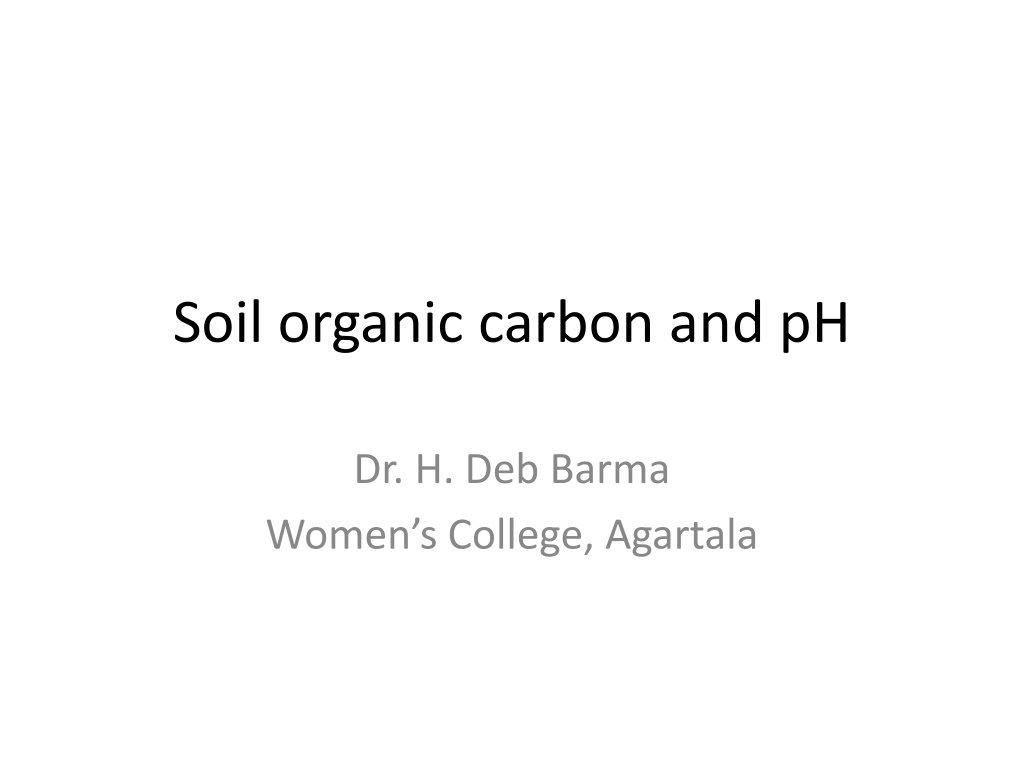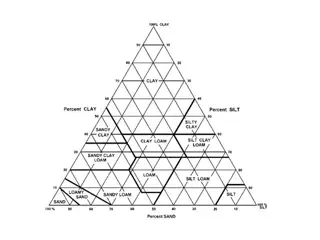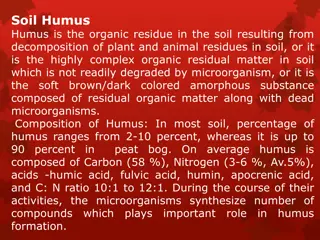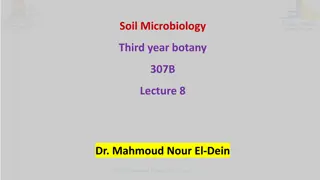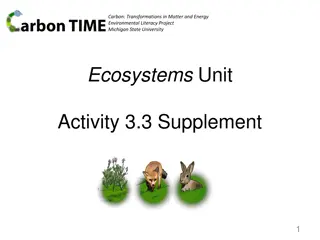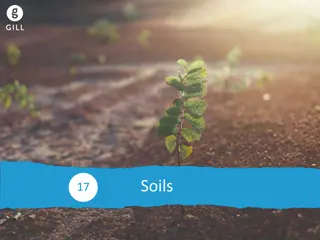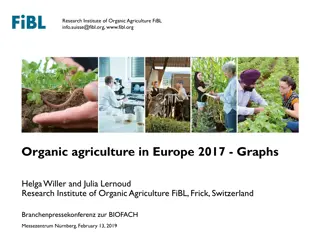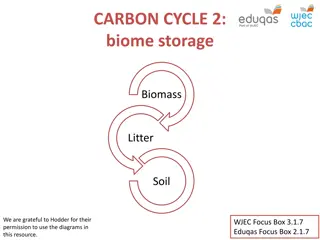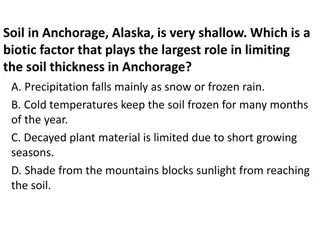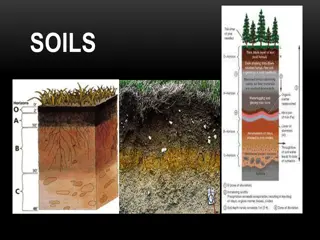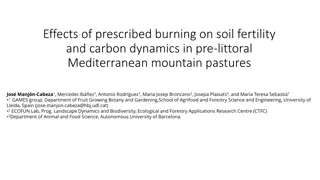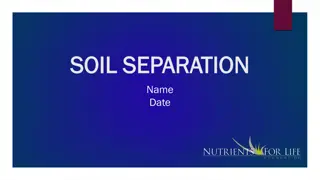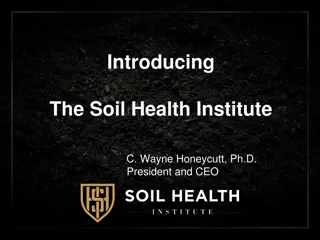Soil organic carbon and pH
Soil organic carbon, a measurable component of soil organic matter, plays a crucial role in soil acidity control, nutrient cycling, and pollutant degradation. Learn about the differences between soil organic carbon and soil organic matter, the composition of soil organic matter, and the distinct fractions it exists as in soil.
Download Presentation

Please find below an Image/Link to download the presentation.
The content on the website is provided AS IS for your information and personal use only. It may not be sold, licensed, or shared on other websites without obtaining consent from the author.If you encounter any issues during the download, it is possible that the publisher has removed the file from their server.
You are allowed to download the files provided on this website for personal or commercial use, subject to the condition that they are used lawfully. All files are the property of their respective owners.
The content on the website is provided AS IS for your information and personal use only. It may not be sold, licensed, or shared on other websites without obtaining consent from the author.
E N D
Presentation Transcript
Soil organic carbon and pH Dr. H. Deb Barma Women s College, Agartala
The second major component of soils is organic matter produced by organisms. The total organic matter in soil, except for materials identifiable as undecomposed or partially decomposed biomass, is called humus. This solid, dark-coloured component of soil plays a significant role in the control of soil acidity, in the cycling of nutrients, and in the detoxification of hazardous compounds. Humus consists of biological molecules such as proteins and carbohydrates as well as the humic substances (polymeric compounds produced through microbial action that differ from metabolically active compounds).
What is soil organic carbon? Soil organic carbon is a measureable component of soil organic matter. Organic matter makes up just 2 10% of most soil's mass and has an important role in the physical, chemical and biological function of agricultural soils. Organic matter contributes to nutrient retention and turnover, soil structure, moisture retention and availability, degradation of pollutants, and carbon sequestration (removal or separation).
How is soil organic carbon different to soil organic matter? Soil organic carbon (SOC) refers only to the carbon component of organic compounds. Soil organic matter (SOM) is difficult to measure directly, so laboratories tend to measure and report SOC.
What is soil organic matter? SOM is composed mainly of carbon, hydrogen and oxygen, and has small amounts of other elements, such as nitrogen, phosphorous, sulfur, potassium, calcium and magnesium contained in organic residues. It is divided into living and dead components and can range from very recent inputs, such as stubble (stumps of grains and other stalks left in the ground when the crop is cut), to largely decayed materials that are thousands of years old. About 10% of below- ground SOM, such as roots, fauna and microorganisms, is living (Figure 1).
SOM exists as 4 distinct fractions which vary widely in size, turnover time and composition in the soil (Table 1): dissolved organic matter particulate organic matter humus resistant organic matter.
Figure 1 Most soil organic matter is dead or decaying, with living organisms making up about 10% of the soil organic matter pool
Rating chart for soil test data https://agritech.tnau.ac.in /agriculture/agri_soil_soilr atingchart.html
Soil pH Soil pH is a measure of the soil s relative acidity or basicity. The pH scale ranges from 0 to 14. A pH of 7 is a neutral state, representing the value found in pure water. Values above 7.0 are basic, while values below 7.0 are acidic. The pH scale is logarithmic, meaning each unit has a 10-fold increase of acidity or basicity. Thus, compared to a pH of 7.0, a pH of 6.0 is ten times more acidic, and a pH of 5.0 is 100 times more acidic.
https://www.google.com/imgres?imgurl=https%3A%2F%2Fwww.jonathangreen.com%2Fwp-content%2Fuploads%2F2016%2F06%2FImportance-https://www.google.com/imgres?imgurl=https%3A%2F%2Fwww.jonathangreen.com%2Fwp-content%2Fuploads%2F2016%2F06%2FImportance- of-pH-scale-3-863x318.png&imgrefurl=https%3A%2F%2Fwww.jonathangreen.com%2Fimportance-soil-ph.html&tbnid=RCHMrmU0eD- UhM&vet=12ahUKEwjA1Zyx0KXyAhX8hUsFHT_cDW8QMygBegUIARC2AQ..i&docid=iHIA4c4zyJePNM&w=863&h=318&q=ph%20soil%20in%20soil &ved=2ahUKEwjA1Zyx0KXyAhX8hUsFHT_cDW8QMygBegUIARC2AQ
Nutrient Availability and pH The optimum pH for a plant varies with organic matter content and plant type. Plant nutrient availability is strongly tied to the pH in the soil solution. Decreasing soil pH directly increases the solubility of the plant nutrients manganese (Mn), zinc (Zn), copper (Cu), and iron (Fe). Acidic soils make these nutrients more available.
Adjusting pH If the soil pH is too basic for the desired plant, incorporating an acidic soil amendment such as pine bark or compost, or applying elemental sulfur, will lower soil pH. Apply sulfur with caution; too much can harm plants. If the soil pH is too acidic, apply lime to raise the soil pH. There are two general classes of liming materials: calcitic (without magnesium) and dolomitic (with magnesium). Calcitic lime is composed of calcium carbonate (CaCO3) and can be used on soils high in magnesium. Dolomitic lime is a mixture of calcium and magnesium carbonates (CaCO3and MgCO3), which is the preferred liming material for soils low in magnesium.
Reference https://www.britannica.com/science/soil/Soil- formation https://www.agric.wa.gov.au/measuring-and- assessing-soils/what-soil-organic-carbon
